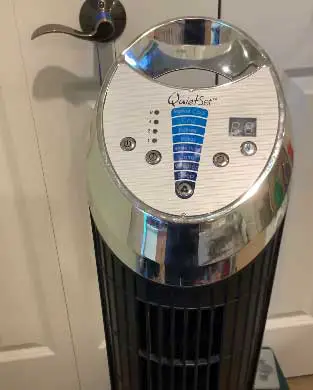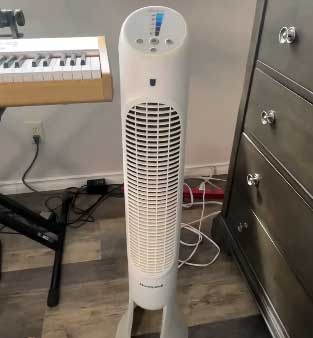Tower fans can be an attractive and space-saving solution for cooling needs at home or the office.
Two of the top brands in tower fans are Holmes and Honeywell.
But how do you decide between these two reputable manufacturers when choosing the best tower fan?
In this comparison article, we’ll analyze key factors like design, features, power, noise level and other specs to see how Holmes and Honeywell tower fans match up.
We’ll also look at real user reviews on aspects like ease of use, durability and customer satisfaction.
A Brief Comparison Table
| Feature | Holmes | Honeywell |
| Design | Slim, oscillating tower with control panel on top | Slim, oscillating tower with LED control panel on front |
| Height | Between 31 – 41 inches | Between 31 – 41 inches |
| Weight | 8 to 16 pounds | 7 to 12 pounds |
| Number of Speeds | Up to 4 | Up to 8 |
| Oscillation | Yes | Yes |
| Remote Control | Some models | Some models |
| Programmable/Timer | Some models | Most models |
| Noise Level | 25 – 45 dB on low | 25 – 46 dB on low |
| Airflow | Up to 500 CFM | Up to 800 CFM |
| Additional Features | Ionizer on some models | Touch controls, carrying handles and sleep timer on some models |
Key Differences Between Holmes And Honeywell Tower Fans
- Design

In terms of design, Holmes and Honeywell tower fans share quite a few similarities.
They both feature tall, narrow, space-saving builds to facilitate air circulation from floor to ceiling.
The grills enclosing the blades are located towards the back rather than the front of the units.
Most Holmes tower fans have manual knobs or buttons on the top control panel.
Honeywell towers may include these on top, but some models also incorporate LED panels with touch buttons on the front. This allows more convenient access.
Available colors are also something to factor in from an aesthetic viewpoint. Holmes towers tend to come in black, white and silver shades. Some Honeywell models like the Fresh Breeze offer a sleek black design, while others like the HYF500 incorporate white casing for a clean, contemporary look.
If ease-of-use and visual appeal are important variables, Honeywell gets the edge for seamless touch controls and wider color/finish options on some products in its tower fan catalog.
Holmes, on the other hand, wins when simple function with limited bells and whistles is the priority.
- Power, Settings & Features
A major difference between Holmes and Honeywell tower fans lies in airflow power and settings flexibility. Holmes towers provide between 3 and 4 fan speeds, while Honeywell models offer power settings ranging from 4 all the way up to 8 speeds.
This allows users to really fine-tune airflow.
For some spaces and situations, the lower CFM offered by Holmes towers is sufficient. But the more robust motors in Honeywell fans translate to greater maximum airflow output – up 800 CFM on high models like the HYF500 and HYF260.
So for larger rooms or extremely hot conditions, they can move a higher volume of air for fast cooling.
Most Holmes and Honeywell tower fans provide oscillation for full room circulation. But beyond basics like a programmable shut-off timer that conserves energy, Honeywell sets itself apart with a few extra convenience features found on certain models:
- Touch Controls – Allow smooth, intuitive speed adjustments
- Sleep Mode – Automatically dims control panel light and reduces sound
- Carrying Handles – For easy portability around the home
- Remote Control – Enables adjusting the fan from across the room
So if customization, smart settings and added functions matter to you, Honeywell towers are the way to go. Holmes still gets the task of cooling done with cheaper price points, but involve simpler, no-frills operation.
- Noise Output

A buying consideration for many shoppers is noise level, especially for bedrooms.
You don’t want an obtrusive roar disrupting sleep.
Both Holmes and Honeywell advertise decibel ratings as low as 25-45 dB for their tower fans on the lowest speed settings.
These produce acceptable ambient background hum.
On higher speeds, noise output understandably increases – but still within 50-65 dB depending on model.
This volume is akin to everyday conversation levels. For context, a standard refrigerator runs at around 40 dB.
Upon analyzing numerous consumer reviews, Holmes and Honeywell are on par when it comes to operating quietly enough for most users. Some Holmes owners note minor rattling issues after months of use, while a few Honeywell buyers report clicking sounds at certain oscillation angles.
But these seem to be isolated incidents not experienced by the majority.
- Reliability & Durability
An important evaluation metric is how reliably a tower fan holds up over months and years of regular seasonal use. Both Holmes and Honeywell boast reputations for manufacturing generally durable, long-lasting appliance products.
Tower fan reviews reflect similar stability for both brands in remaining functional 3+ years.
However, a common pain point cited by a portion of Holmes tower owners is inadequate customer service response when malfunctions do arise outside the 1-year warranty period. Holmes gets called out for lacking in follow-up support.
Honeywell on the flip side draws consistent praise for its post-purchase assistance. Many reviewers experiencing minor glitches note that Honeywell promptly sends replacement parts or entire substitute tower fans even beyond stated coverage terms. This earns major brand loyalty points.
For sustained viability requiring minimal servicing, Holmes and Honeywell tower fans appear comparable. But Honeywell’s customer-centric policies give them an edge in ensuring extended usability.
- Ease of Use
Operating any appliance like a tower fan ideally needs to promote simplicity for the user. When it comes to powering on, changing speeds, setting timers and oscillation – both Holmes and Honeywell tower fans receive passing marks for user-friendliness from online reviewers.
Owners generally find their functions intuitive without complicated learning curves.
However, a key distinction emerges when it comes to cleaning and maintenance. Numerous Holmes tower owners complain about the cumbersome process of dismantling housing components to access and wipe fan blades. Excessive dust/debris then inevitably accumulates at hard-to-reach crevices.
Contrast this with Honeywell towers where the front grills and rear intakes detach swiftly for full, convenient blade access. The ease of properly cleaning Honeywell models leads to smoother long-term performance.
So Honeywell certainly bests Holmes for maintenance user-friendliness.
- Cost Comparison

Budget matters too when selecting between tower fan brands.
Holmes prices range from $35 for simple models to $150 for higher-end ones with bonus features.
You’ll spend $60 to $250 for comparable specs among Honeywell tower fans.
So all else being equal, Holmes towers retail for 15-20% cheaper as of this writing.
However, wider sales distribution for the Honeywell brand means better chances of grabbing markdown deals at major retailers like Walmart and Amazon.
This helps offset some of the baseline pricing difference when timing it right.
If absolute minimum spend is the main motive, Holmes edges out Honeywell just slightly. But factoring in periodic discounts and overall value derived from customer reliability and product versatility, Honeywell remains competitive bang for buck.
Frequently Asked Questions (FAQ)
Some top-rated tower fan brands and models based on consumer reviews and product testing include:
1. Honeywell HYF290B – Quiet 8-speed remote-controlled tower with auto shut-off timer
2. Dyson AM07 – Higher-end bladeless tower fan with 10 airflow settings
3. Lasko T42950 – Budget-friendly 3-speed oscillating tower under $50
4. Vornado 660 – Whole room vortex air circulation with 4 speed settings
5. Seville Classics Ultra Slimline – 40-inch super space-saving tower design
Yes, Honeywell is highly reputable for manufacturing durable, high-performing home appliances like fans. Their tower fans offer excellent range of airflow speeds, convenient custom features and reliable long-term operation. Customers praise Honeywell for quality construction and responsive post-purchase support.
Some of the most trusted fan brands ranked very well by both experts and consumers are Dyson, Honeywell, Vornado, Lasko, Rowenta, Holmes, Seville Classics and Ozeri. Top products provide powerful, quiet airflow across room/tower/pedestal configurations. Key brand strengths vary from bladeless tech to whole-room circulation and remote controls.
Many reviewers cite Honeywell tower fans as the easiest to clean thoroughly. Front grills and rear intakes remove swiftly for full access to blades and interior. Dust and debris don’t get trapped. Other quality brands like Dyson also allow convenient blade cleaning without full disassembly.
Bottom Line
After this comprehensive comparison analysis, Holmes and Honeywell tower fans each shine in different performance aspects:
Holmes Pros
- More budget-friendly list pricing
- Simpler manual operation
- Compact, utilitarian design
Honeywell Pros
- Higher airflow capacity
- More advanced features/customization
- Touch controls and sleek aesthetics on some models
- Industry-leading customer service reputation
Casual users content with basic cooling functionality may find Holmes tower fans fully sufficient for their needs while spending less upfront. However, shoppers wanting robust airflow, programmable settings, user-centric support and longer-lasting quality are wise to invest just a little more for Honeywell.
So choosing between Holmes and Honeywell towers comes down to knowing your must-have priorities, then matching specifications and brand attributes accordingly. Determine whether no-frills practicality or high-performance versatility matters more for your household.
